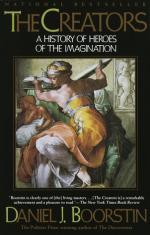
|
| Name: _________________________ | Period: ___________________ |
This test consists of 15 multiple choice questions and 5 short answer questions.
Multiple Choice Questions
1. What was the subject of Monet's art?
(a) His own perceptions.
(b) Architecture.
(c) Nature.
(d) Human figures.
2. What was the relationship between Wordsworth and Coleridge?
(a) Enemies.
(b) Competitors.
(c) Collaborators.
(d) Teacher and student.
3. How did the orchestra change in the fifteenth century according to Boorstin?
(a) Conductors were introduced to coordinate parts.
(b) They swelled to unprecedented size.
(c) Instruments were grouped into families.
(d) Composers began to employ new forms of harmony and dissonance.
4. What did Gibbon add to the genre of human comedy according to Boorstin?
(a) The saga of empire.
(b) The biography of kings.
(c) The historical novel.
(d) The fairy tale of history.
5. What does Boorstin say does the artist's job in photography?
(a) Light.
(b) The image itself.
(c) The machine.
(d) The developer.
6. What did Bondone create according to Boorstin?
(a) A new form of Christian allegory.
(b) A personal vision of Christian archetypes.
(c) Individuality in visual arts.
(d) Human figures who transcended religion.
7. In what does Zola say man stopped believing in the epigraph to Book 3?
(a) God.
(b) Himself.
(c) His own mortality.
(d) His own immortality.
8. How does Boorstin characterize the form of Whitman's poetry?
(a) Unconventional.
(b) Post-modern.
(c) Symmetrical.
(d) Modernist.
9. For what does Boorstin say skyscrapers were first used?
(a) Advertising.
(b) Defense.
(c) Commerce.
(d) Industry.
10. Boorstin says that Dickens' work was a love affair with what?
(a) The New World.
(b) English history.
(c) The English people.
(d) Future technologies.
11. What did the Slavonic Dostoevskian character represent for the Western imagination according to Boorstin?
(a) Experiences at the heart of Western consciousness.
(b) The primitive memories out of which Western consciousness arose.
(c) Experiences beyond the Western consciousness.
(d) The duality present in Western consciousness.
12. What does Boorstin say Giotto di Bondone was the first Western artist to do?
(a) Depict the human nude.
(b) Bring Christian archetypes to life.
(c) Tell stories in paintings.
(d) Include text in his paintings.
13. Mozart composed eight symphonies, four divertimentos and some sacred works in a few months at what age?
(a) 22.
(b) 11.
(c) 16.
(d) 4.
14. How does Boorstin say Proust created life?
(a) In space.
(b) In time.
(c) In action.
(d) In ritual.
15. On what did Melville reflect in Moby Dick according to Boorstin?
(a) American industrial expansion.
(b) The paradox of good and evil.
(c) American exceptionalism.
(d) The problem of indigenous culture in the New World.
Short Answer Questions
1. What does Boorstin say Bruneleschi and Alberti rediscovered?
2. How does Koestler characterize creativity in the epigraph to Book 3?
3. What does Boorstin say Rousseau's Confessions are a self-defense against?
4. What history did Prescott and Parkman write?
5. In what way does Boorstin say Milton was a strong individual?
|
This section contains 490 words (approx. 2 pages at 300 words per page) |

|




